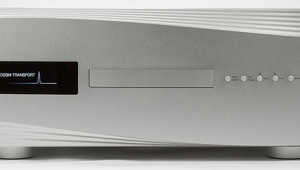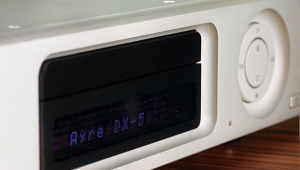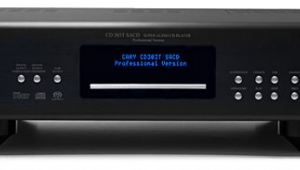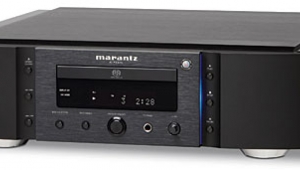| Columns Retired Columns & Blogs |
Nagra D open-reel digital recorder
As I write these words, it's the height of the fall catalog season in the Atkinson household. Whole old-growth forests must have died to ensure the everyday stuffed state of our mailbox, which adds to the sense of guilt I feel as I pitch the offenders into the trash without even giving their insides a passing glance. But there are three catalogs I do look forward to receiving, that I read from cover to cover, that I deface with multicolored Post-It notes. The Audio Advisor catalog is, of course, a no-brainer for an audiophile. But the Griot's Garage and Levenger catalogs get equal billing from me. For both offer tools (used in the widest sense of the word) that appear to have been designed by people who actually use tools, who appear to care about quality, and who appear to feel that a product that breaks while it is being used for its intended task is an offense against God (footnote 1).
Footnote 1: For everything the compleat audiophile could or would wish for: The Audio Advisor Inc., 4649 Danvers Drive SE, Kentwood, MI 49512. Tel: (800) 942-0220. For mechanical tools of every kind: Griot's Garage, 3500-A 20th Street E., Tacoma, WA 98424. Tel: (800) 345-5789. For bookshelves, bookcases, desks, wooden file cabinets, reading chairs, and writing implements: Levenger Tools For Serious Readers, 420 Commerce Drive, Delray Beach, FL 33445-4696. Tel: (800) 544-0880.—John Atkinson
 I got the same feeling when I first laid my hands on a Nagra open-reel analog tape recorder. Widely used by film-sound location recordists in its various generations, the Swiss-made Nagra is a small, elegant, immaculately engineered expression of form-follows-function. The battery-powered machine works as anyone with any recording experience would wish; nothing is unnecessary; every component is designed with an eye to how well it needs to be engineered to fulfill its function; the result is maximum quality, both physical and sonic.
I got the same feeling when I first laid my hands on a Nagra open-reel analog tape recorder. Widely used by film-sound location recordists in its various generations, the Swiss-made Nagra is a small, elegant, immaculately engineered expression of form-follows-function. The battery-powered machine works as anyone with any recording experience would wish; nothing is unnecessary; every component is designed with an eye to how well it needs to be engineered to fulfill its function; the result is maximum quality, both physical and sonic.
And when I cast my eyes a few years back on a Studio Sound review of the Kudelski company's first digital recorder, the open-reel Nagra-D, it appeared to live up to the Nagra tradition, packing a huge amount of superbly engineered, computer-controlled functionality within its tiny frame. You need something—the Nagra-D has it or can interface with it. You want to do something—the Nagra-D can do it. In fact, the reviewer's only substantive criticism was that when the machine was being used for film-sound location recording—its primary purpose—it would be possible for mud to get inside while changing batteries!
D is for digital
Like a DAT recorder, the Nagra-D uses a rotating record/playback head drum—two VHS-type record heads, two playback heads—to lay down the data on the 6.25mm-wide (¼") tape as a succession of narrow (0.07mm) diagonal tracks, each 44.2mm long (footnote 2). Unlike a DAT recorder, this "scanner" is mounted in full view of the outside world, on the D's top plate (although the transparent top cover is always kept closed during operation once the tape has been threaded). Almost 2" in diameter (49.3mm), the drum rotates at 3750rpm/62.5rps (48kHz sampling), giving a linear write/read speed of around 9.9m/s (390ips), which enables it to record the video-bandwidth signal representing up to four channels of 24-bit digital data.
When the Play or Record buttons are pressed, nothing happens until the scanner has accelerated to its correct rotational speed. During this time, the yellow Ready LED flashes. Once the scanner is up to speed, actuators move the tape into contact with it, giving an M-shaped tape path. If you press Stop, the scanner keeps on rotating for 60 seconds in order to be ready for instant play or record. Pressing Ready with the scanner stationary starts it rotating. The default off-tape monitoring is read-after-write; if you don't hear anything, you aren't laying data down on tape!
The tape also has three conventional (longitudinal) tracks, recorded by a stationary head to the left of the scanner. On the very edge of the tape is the time-code track, with standard SMPTE code (all variations are possible) laid down in a format that can be read at high speed; the Nagra-D therefore can read where it is while a tape is being fast-wound or rewound. Inside the time-code track is a control track, which stores marker information about where each helical scan starts, in order for the scanner heads to be properly synchronized with the tape data tracks. The third track is an analog cue track. This records a mono mix of the four data channels, along with user comments input via an optional microphone. When the tape is being wound or rewound, the headphone output is switched to the cue track output.
To make the Nagra-D reviewer-proof, the tape path is engraved in black on the top panel. To thread the machine, you just follow the guide. (I still managed to do it wrong a couple of times, but I had to try really hard.) The D has extensive error correction; touching the tape surface will not generally result in fatal data dropouts, but it's not recommended. Likewise, while the tape can be edited with a razor blade, it's not necessary.
Physically, four of the machine's surfaces carry controls. The top plate carries the tape transport, scanner, and the tape transport controls. Just above them, an LCD panel displays time code and, more importantly, allows the user to step through the complex command menu, using the Side Arrow, Down Arrow, and Execute keys. The overall menu is too complex to describe in the space available here, but trust me: just about every aspect of the Nagra-D's operation can be adjusted/optimized using just these three keys.
Footnote 1: For everything the compleat audiophile could or would wish for: The Audio Advisor Inc., 4649 Danvers Drive SE, Kentwood, MI 49512. Tel: (800) 942-0220. For mechanical tools of every kind: Griot's Garage, 3500-A 20th Street E., Tacoma, WA 98424. Tel: (800) 345-5789. For bookshelves, bookcases, desks, wooden file cabinets, reading chairs, and writing implements: Levenger Tools For Serious Readers, 420 Commerce Drive, Delray Beach, FL 33445-4696. Tel: (800) 544-0880.—John Atkinson
Footnote 2: Described in an AES paper "Digital Audio Recording Format Offering Extensive Editing Capabilities" (Preprint 2481), by S. Kudelski, J.-C. Schlup, A. Kudelski, M. Sasseli, C. Werner, and S. Engeström, presented at the 82nd Audio Engineering Society Convention, London, March 1987.—John Atkinson
- Log in or register to post comments




































